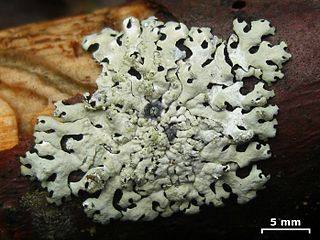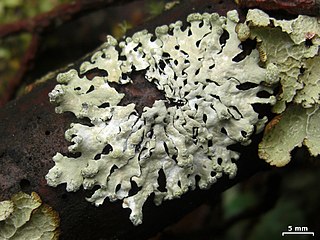
The Parmeliaceae is a large and diverse family of Lecanoromycetes. With over 2700 species in 71 genera, it is the largest family of lichen-forming fungi. The most speciose genera in the family are the well-known groups: Xanthoparmelia, Usnea, Parmotrema, and Hypotrachyna.

Hypotrachyna is a genus of lichenized fungi within the family Parmeliaceae. According to the Dictionary of the Fungi, the widespread genus contains about 198 species. Hypotrachyna was circumscribed by American lichenologist Mason Ellsworth Hale Jr in 1974.

Hypotrachyna taylorensis is a species of foliose lichen in the family Parmeliaceae. Described by M.E. Mitchell in 1961, and transferred to genus Hypotrachyna by Mason Hale in 1975, the lichen occurs in the Appalachian region of North America.
Hypotrachyna angustissima is a species of foliose lichen in the family Parmeliaceae. This species is characterised by the occurrence of usnic acid in its cortex, and salazinic acid in its medulla and laminal isidia. In this it resembles Hypotrachyna microblasta, but the latter has wider laciniae and larger apothecia, and is laterally overlapping. Its epithet angustissima is derived from the Latin angusti, meaning "narrow", due to this species' very narrow laciniae.
Hypotrachyna oprah is a species of foliose lichen in the family Parmeliaceae. Found in the United States in North Carolina, Alabama, and Florida, it was described as new to science in 2019 by lichenologists James Lendemer and Jessica Allen. It was named in honor of Oprah Winfrey. It contains the secondary chemical lichexanthone.
Remototrachyna is a genus of foliose lichens in the large family Parmeliaceae. It was separated from the genus Hypotrachyna based on the structure of the excipulum and genetic differences.
Hypotrachyna vainioi is a species of foliose lichen in the family Parmeliaceae. It is found in Brazil.
Hypotrachyna is a species of foliose lichen in the family Parmeliaceae. Originally described from specimens collected in Venezuela, it is found in mountains throughout the Neotropics, where it grows on pine and hardwood bark.
Hypotrachyna ahtiana is a species of foliose lichen in the family Parmeliaceae. It is known only from the type locality in Venezuela, where it was collected in the Guyana Shield at an elevation of 1,950 m (6,400 ft). It is named to honour Finnish lichenologist Teuvo Ahti.
Hypotrachyna alectorialiorum is a species of foliose lichen in the family Parmeliaceae. It is known only from the type locality in Minas Gerais, Brazil, where it was found growing on soil over rock, at an elevation of 1,200 m (3,900 ft). The specific epithet refers to the presence of the secondary chemicals alectorialic acid and hypoalectorialic acid.
Hypotrachyna andensis is a species of foliose lichen in the family Parmeliaceae. It is known to occur in the Neotropics and in Papua New Guinea.
Hypotrachyna anzeana is a species of foliose lichen in the family Parmeliaceae. It occurs in the Andes of Colombia and Bolivia, where it grows over moss cushions on acidic rocks at an elevation of 3,500–3,900 m (11,500–12,800 ft). The specific epithet honours the collector of the type specimen, the environmental biologist Rafael Anze Martin.
Hypotrachyna aspera is a species of foliose lichen in the family Parmeliaceae. It occurs in the mountains of Minas Gerais and Paraná, where it grows on tree bark in humid forests at an elevation of about 1,100 m (3,600 ft).
Hypotrachyna bogotensis is a species of foliose lichen in the family Parmeliaceae. It was first described scientifically by Finnish lichenologist Edvard August Vainio. Mason Hale transferred it to the genus Hypotrachyna in 1975. It is a common species in the high mountains of the Central America and the northern Andes. It has also been recorded from southern Chile and from Gough Island.
Hypotrachyna boquetensis is a species of foliose lichen in the family Parmeliaceae. It was first described scientifically by lichenologist Mason Hale as a member of the genus Parmelia; he transferred it to the genus Hypotrachyna a year later. It is found in the mountains of Central and northern South America, where it grows on hardwood trunks and branches at elevations of 1,400–2,800 m (4,600–9,200 ft). It has also been recorded from India.
Hypotrachyna brasiliana is a species of foliose lichen in the family Parmeliaceae. It was originall described by William Nylander in 1885 as a species of Parmelia. Mason Hale transferred it to the new genus Hypotrachyna in 1975. The lichen is found in the mountains of southeastern Brazil at elevations of 800–2,400 m (2,600–7,900 ft), where it grows on siliceous rocks, or on mosses over rocks.
Hypotrachyna brevidactylata is a species of foliose lichen in the family Parmeliaceae. It is an uncommon species that occurs in the mountains of Costa Rica, and in the Andes of Bolivia and Ecuador, at elevations of 2,500–3,600 m (8,200–11,800 ft). Its specific epithet refers to its resemblance to Hypotrachyna brevispora, and the presence of laminal dactyls.
Hypotrachyna brueggeri is a species of foliose lichen in the family Parmeliaceae. Described as a new species in 2002, it is known only from the type locality in southeastern Brazil, where it was collected at elevations of 1,000–1,400 m (3,300–4,600 ft).

Hypotrachyna osseoalba, commonly known as the grainy loop lichen, is a species of foliose lichen in the family Parmeliaceae. It is widely distributed in subtropical and temperate areas of the world. Characteristic features of the lichen include the pustules in its cortex, the somewhat linear shape of the lobes comprising the thallus, and the branched rhizines.
Remototrachyna sipmaniana is a species of saxicolous (rock-dwelling), foliose lichen in the family Parmeliaceae. It is only known to occur in Bolivia, where it grows on boulders in Yungas mountain cloud forests.


